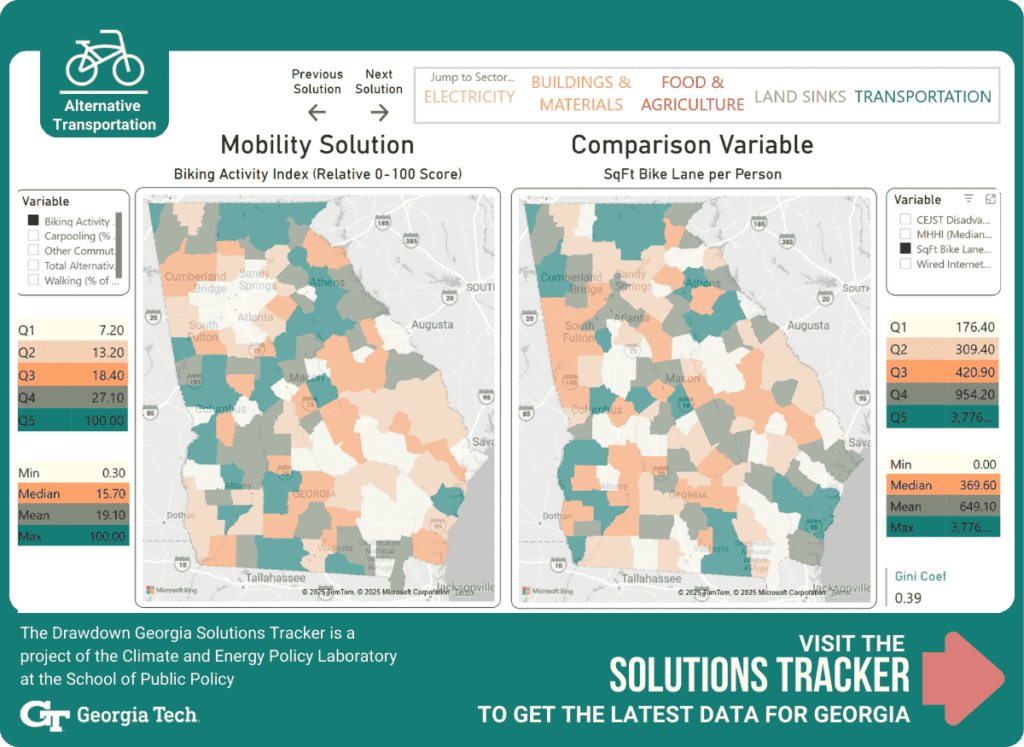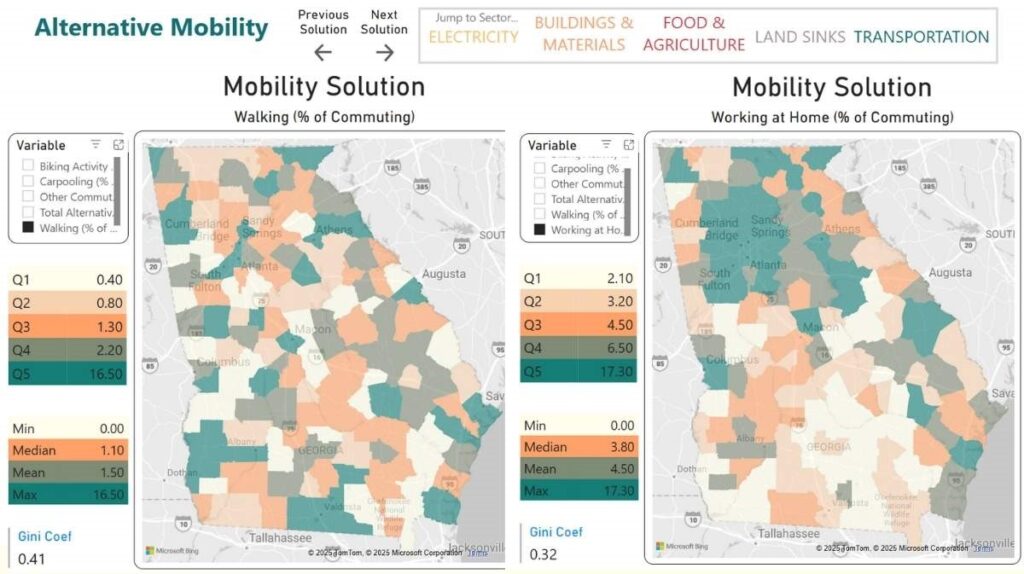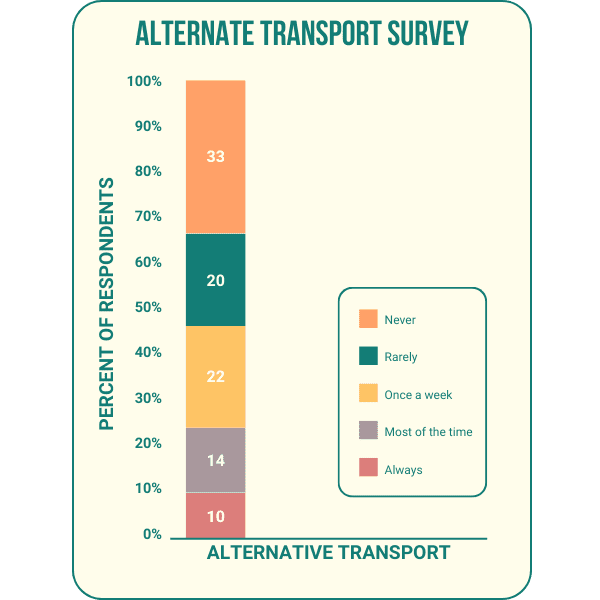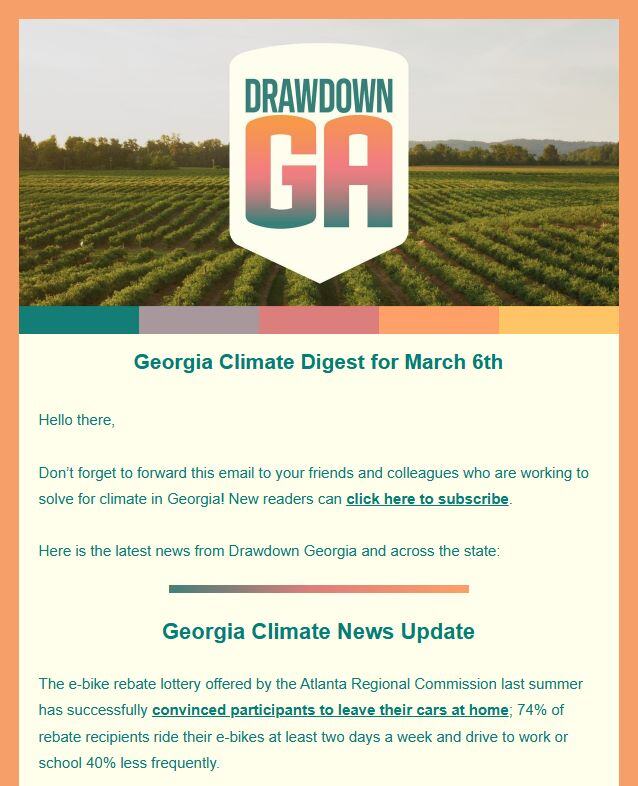The Benefits of Alternative Transportation
Replacing emissions-intensive vehicle miles traveled with zero- or low-carbon alternatives such as bicycling, walking, or teleworking reduces greenhouse gas emissions. This includes replacing short-distance trips with these alternatives: bike infrastructure, walkable cities, telepresence, and e-bikes.
Access Alternative Transportation Resources from Drawdown Georgia
Market Readiness and Available Technology
These technologies are mature and market-ready. Telecommuting and alternative mobility solutions, such as bicycles, are already widely used worldwide and have some presence in Georgia. Given the minimal current presence of biking and alternative mobility, there is significant potential to reduce carbon emissions by replacing carbon-intensive car trips with low-carbon alternatives.
Telecommuting has even greater potential. With advances in video conferencing and teleworking solutions, there is significant potential to reduce vehicle miles by implementing teleworking policies, and many businesses and organizations already employ teleworking (or remote and hybrid work) as a strategy to improve employee satisfaction and reduce operating costs.
Alternative Transportation as a Climate Solution in Georgia
The Drawdown Georgia research team estimates that Georgia could reduce emissions by one megaton (Mt) of CO2e by eliminating just 2.5% of vehicle miles traveled by 2030.
What is the Carbon Emissions Reduction Potential by 2030?
Achievable reduction potential is derived by taking the technical reduction potential, outlined below, and developing a more realistic forecast that takes current rates of deployment, market constraints, and other barriers into consideration.
For alternative transportation, the Drawdown Georgia research team has calculated the achievable reduction potential to be 0.84 Mt of CO2e.
What Is the Upper Limit of Carbon Emissions Reduction Potential?
Technical reduction potential reflects the upper limit of emissions reductions for this solution without regard to the constraints that exist in the real world, such as economic or political considerations.
For alternative transportation, the Drawdown Georgia research team has calculated the technical reduction potential to be 21.5 Mt.
Alternative Transportation in Georgia Today
The Federal Highway Administration’s National Transportation Survey has detailed data for vehicle miles traveled (VMT) at the state level, which can be used to estimate reductions in VMT resulting from more widespread use of alternative mobility measures.

The Biking Activity Index map shows that urban areas like Atlanta, Athens, and Savannah have the lowest scores, indicating lower levels of biking activity per capita, likely due to their higher populations. In contrast, rural and suburban areas have higher scores, reflecting more biking engagement per capita.
This is likely because Strava (the app used to determine bike activity) tracks not only commuter rides but also rides for recreation, like mountain biking or recreational road cycling. The median score being less than the mean shows that the bulk of the values are lower, with a few outliers.

We know that a very low percentage of commuters walk to work, but there are some counties with outlier values for this metric. Interestingly, most of the outliers in terms of walking to work are in counties that have military bases (Fort Benning and Fort Stewart), likely because they are living on-base.

A Georgia Tech/University of Georgia survey, funded by Drawdown Georgia, polled nearly 1,700 state residents and found that over 75% of respondents use alternative transportation once a week or less.
Several cities around the state are planning or have started implementing improvements to bicycling and walking infrastructure, such as the Transportation Alternative Program (TAP), Georgia Commute Options (GCO), and the Atlanta Regional Commission (ARC). Challenges in measuring the impacts include a lack of data relating to existing biking and telecommuting data as well as historical trends of these data.
Progress on Alternative Transportation in Georgia
Since the pandemic increased remote and telework, many organizations have moved to a virtual or hybrid modality for work. The Bipartisan Infrastructure Law funding for rural broadband may make this possible for rural populations that were previously unable to work virtually due to the lack of access to high-speed internet.
Furthermore, shared micro-mobility options like Bird or Lime scooters have become more available in population centers like Atlanta, which recently extended the operational time for their scooters.
The Atlanta E-Bike Rebate Program, launched in June 2024, aims to make e-bikes more affordable. The program offers rebates of $500–$2,000, with higher amounts for income-qualified residents, and rebates must be redeemed at participating local bike shops. Demand was overwhelming, with nearly 9,000 applicants in the first week, leading to a lottery-based selection process. In total, 579 rebates were awarded, with 82% going to income-qualified applicants. Additional rebates may be offered if more funding becomes available.
How Reliable Is Our Estimate For This Drawdown Georgia Climate Solution?
The greenhouse gas reduction potential is high, assuming that vehicle miles traveled for urban local trips can be substituted by biking, walking, and/or telepresence. For example, preliminary analysis using data from the Federal Highway Administration’s National Household Transportation Survey indicates that for bike infrastructure alone, a substitution of 1 out of 10 of urban local car trips (under 3 miles) by bikes could abate over 1 megaton (Mt) CO2 annually.
Additional substitution of vehicle trips by walking, telepresence, and/or e-bikes is expected to contribute to further abatement. In particular, telecommuting has high CO2 reduction potential because telepresence can offset longer trips and thus more vehicle miles traveled. Average market penetration of telepresence one day per week could reduce vehicle miles traveled by nearly 20 percent. Combined with other market trends such as co-working and synergies with biking and walking, there is ample achievable carbon emissions reduction potential.
Cost Competitiveness
A review of the literature and expert survey feedback indicates that this Drawdown Georgia solution is cost-competitive, especially because bike infrastructure negates the need for new motorized vehicle infrastructure.
Alternative transportation and telepresence also reduce private expenditures on transportation, and if managed properly, telepresence can reduce the need for physical office space. Further, reduced commuting can reduce congestion and improve air quality.
Beyond Carbon Attributes
Benefits include improved air quality from reduced emissions and improved water quality from reduced particulates and debris from cars that end up in stormwater runoff. A drop in traditional commuting also reduces wear and tear on local infrastructure, thereby lowering roadway construction and maintenance costs.
Social benefits include improved public health due to increased physical activity and improved mental health for individuals. Increased social interaction can benefit local businesses, reduce noise pollution caused by traffic, and reduce local traffic & parking challenges. Telecommuting reduces the productivity loss attributed to time lost in traffic jams, which was estimated to be $74 billion in the United States in 2024. Moreover, the improved health of workers can lead to decreased workplace accidents due to fatigue and total sick days.
An equity-related concern is that adoption rates for this solution would vary between urban and rural communities, which may lead to possible gentrification impacts. On the other hand, insufficient dispersion of infrastructure for alternative mobility routes may discourage vulnerable communities from adopting these options and cause social disparity in the degree of access.
An additional concern involves an increased number of bikes (or other mobility devices) and car accidents if the resources and infrastructure upgrades such as bike lanes are not made available.



